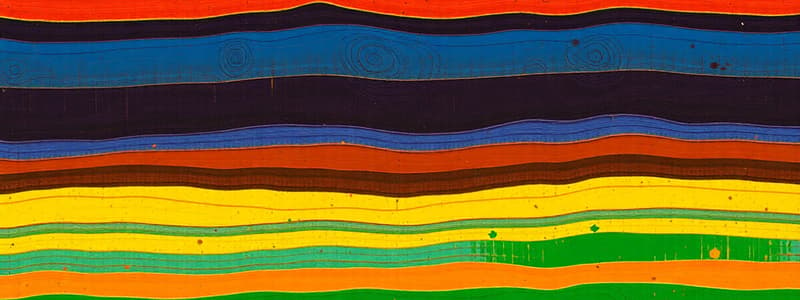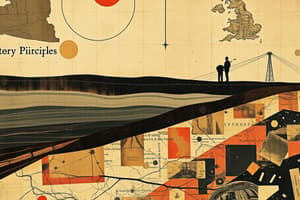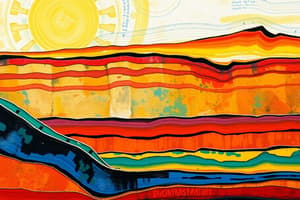Podcast
Questions and Answers
Which principle states that in an undisturbed sequence of sedimentary rocks, the oldest layers are at the bottom and the youngest are at the top?
Which principle states that in an undisturbed sequence of sedimentary rocks, the oldest layers are at the bottom and the youngest are at the top?
- Principle of Superposition (correct)
- Principle of Cross-Cutting Relationships
- Principle of Inclusions
- Principle of Lateral Continuity
A geologist finds a fault cutting through several layers of sedimentary rock. According to relative dating principles, which is younger?
A geologist finds a fault cutting through several layers of sedimentary rock. According to relative dating principles, which is younger?
- The principle cannot be applied in this situation
- The sedimentary layers
- The fault (correct)
- The layer furthest away from the fault
Which of the following best describes the Principle of Original Horizontality?
Which of the following best describes the Principle of Original Horizontality?
- Sedimentary layers are initially deposited horizontally. (correct)
- Igneous intrusions are always horizontal.
- Tectonic forces always maintain rock layers in a horizontal position.
- Sedimentary layers are always deposited at steep angles.
What does an unconformity represent in a sequence of rock layers?
What does an unconformity represent in a sequence of rock layers?
In a sequence of sedimentary rocks, a layer of sandstone contains inclusions of granite. Which rock formation is older?
In a sequence of sedimentary rocks, a layer of sandstone contains inclusions of granite. Which rock formation is older?
Which type of unconformity involves horizontal sedimentary layers overlying tilted sedimentary layers?
Which type of unconformity involves horizontal sedimentary layers overlying tilted sedimentary layers?
Which type of unconformity is characterized by sedimentary layers overlying metamorphic or igneous rocks?
Which type of unconformity is characterized by sedimentary layers overlying metamorphic or igneous rocks?
Which of the following is an example of applying the principle of lateral continuity?
Which of the following is an example of applying the principle of lateral continuity?
How are fossils utilized in relative dating?
How are fossils utilized in relative dating?
Which environment is most conducive to the preservation of fossils?
Which environment is most conducive to the preservation of fossils?
What is the significance of index fossils in biostratigraphic correlation?
What is the significance of index fossils in biostratigraphic correlation?
Identify the dating method that measures the time elapsed since silicate minerals were last exposed to light or heat.
Identify the dating method that measures the time elapsed since silicate minerals were last exposed to light or heat.
What is the significance of zircon crystals in dating geological events?
What is the significance of zircon crystals in dating geological events?
What does the term 'closed system' refer to in the context of radioisotopic dating?
What does the term 'closed system' refer to in the context of radioisotopic dating?
Which of the following best describes 'permineralization' as a type of fossil preservation?
Which of the following best describes 'permineralization' as a type of fossil preservation?
What is the half-life of a radioactive isotope?
What is the half-life of a radioactive isotope?
Carbon-14 dating is most suitable for dating what type of materials?
Carbon-14 dating is most suitable for dating what type of materials?
What method did Clair Patterson use to determine the age of the Earth?
What method did Clair Patterson use to determine the age of the Earth?
What is the process of 'alpha decay'?
What is the process of 'alpha decay'?
How does 'beta decay' change the atomic number and mass of an isotope?
How does 'beta decay' change the atomic number and mass of an isotope?
What is a 'decay chain' in the context of radioactive isotopes?
What is a 'decay chain' in the context of radioactive isotopes?
In 'electron capture,' how are the atomic number and mass number affected?
In 'electron capture,' how are the atomic number and mass number affected?
What is measured by a mass spectrometer in radioisotopic dating?
What is measured by a mass spectrometer in radioisotopic dating?
What is the significance of uniformitarianism in geology?
What is the significance of uniformitarianism in geology?
Which is the best use case for fission track dating?
Which is the best use case for fission track dating?
What is lithostratigraphic correlation based on?
What is lithostratigraphic correlation based on?
What is the significance of using multiple parent/daughter pairs in radioisotopic dating?
What is the significance of using multiple parent/daughter pairs in radioisotopic dating?
The geologic time scale was developed using what?
The geologic time scale was developed using what?
What caused Lord Kelvin's estimate of Earth's age to be so far off?
What caused Lord Kelvin's estimate of Earth's age to be so far off?
What is the name of the famous transition fossil between reptiles and birds?
What is the name of the famous transition fossil between reptiles and birds?
What geological feature is often found with a disconformity?
What geological feature is often found with a disconformity?
What information can dinosaur tracks provide?
What information can dinosaur tracks provide?
What does 'chronostratigraphic correlation' match?
What does 'chronostratigraphic correlation' match?
What do onlapping sediments indicate?
What do onlapping sediments indicate?
What is the basic classification unit of life?
What is the basic classification unit of life?
What lifeforms do the most useful index fossils come from?
What lifeforms do the most useful index fossils come from?
What are the largest divisions of time?
What are the largest divisions of time?
What is the study of prehistoric animal tracks called?
What is the study of prehistoric animal tracks called?
Flashcards
Relative Dating
Relative Dating
Determining if one rock or geologic event is older or younger than another, without knowing their specific ages.
Stratigraphy
Stratigraphy
The study of layered sedimentary rocks.
Principle of Superposition
Principle of Superposition
In an undisturbed sequence, bottom layers are oldest, top layers are youngest.
Principle of Original Horizontality
Principle of Original Horizontality
Signup and view all the flashcards
Principle of Lateral Continuity
Principle of Lateral Continuity
Signup and view all the flashcards
Principle of Cross-Cutting Relationships
Principle of Cross-Cutting Relationships
Signup and view all the flashcards
Principle of Inclusions
Principle of Inclusions
Signup and view all the flashcards
Principle of Fossil Succession
Principle of Fossil Succession
Signup and view all the flashcards
Unconformity
Unconformity
Signup and view all the flashcards
Nonconformity
Nonconformity
Signup and view all the flashcards
Disconformity
Disconformity
Signup and view all the flashcards
Angular Unconformity
Angular Unconformity
Signup and view all the flashcards
Absolute Dating
Absolute Dating
Signup and view all the flashcards
Isotope
Isotope
Signup and view all the flashcards
Radioactive Isotopes
Radioactive Isotopes
Signup and view all the flashcards
Half-Life
Half-Life
Signup and view all the flashcards
Alpha Decay
Alpha Decay
Signup and view all the flashcards
Beta Decay
Beta Decay
Signup and view all the flashcards
Electron Capture
Electron Capture
Signup and view all the flashcards
Daughter Isotope
Daughter Isotope
Signup and view all the flashcards
Parent Isotope
Parent Isotope
Signup and view all the flashcards
Mass Spectrometer
Mass Spectrometer
Signup and view all the flashcards
Radiocarbon Dating
Radiocarbon Dating
Signup and view all the flashcards
Fossil
Fossil
Signup and view all the flashcards
Actual Preservation
Actual Preservation
Signup and view all the flashcards
Permineralization
Permineralization
Signup and view all the flashcards
Molds and Casts
Molds and Casts
Signup and view all the flashcards
Carbonization
Carbonization
Signup and view all the flashcards
Trace Fossils
Trace Fossils
Signup and view all the flashcards
Species
Species
Signup and view all the flashcards
Evolution
Evolution
Signup and view all the flashcards
Correlation
Correlation
Signup and view all the flashcards
Stratigraphic Correlation
Stratigraphic Correlation
Signup and view all the flashcards
Lithostratigraphic Correlation
Lithostratigraphic Correlation
Signup and view all the flashcards
Chronostratigraphic Correlation
Chronostratigraphic Correlation
Signup and view all the flashcards
Biostratigraphic Correlation
Biostratigraphic Correlation
Signup and view all the flashcards
Index Fossils
Index Fossils
Signup and view all the flashcards
Geologic Time Scale
Geologic Time Scale
Signup and view all the flashcards
Luminescence Dating
Luminescence Dating
Signup and view all the flashcards
Fission Track Dating
Fission Track Dating
Signup and view all the flashcards
Study Notes
- Relative dating determines if a rock or geologic event is older or younger than another without knowing their specific age.
- James Hutton's uniformitarianism ("the present is the key to the past") allowed interpreting rocks using scientific principles and relative age dating.
Relative Dating Principles
- Stratigraphy studies layered sedimentary rocks.
- Principles of relative time are useful in all of geology and especially stratigraphy.
- Principle of Superposition: In undisturbed sedimentary strata, bottom layers are oldest, and top layers are youngest.
- Principle of Original Horizontality: Sediments and lava flows are originally laid down horizontally, except at basin margins.
- Principle of Lateral Continuity: Strata are continuous in all directions within a depositional basin until they thin out or hit a barrier.
- Principle of Cross-Cutting Relationships: Deformation events (folds, faults, intrusions) are younger than the rocks they affect.
- Principle of Inclusions: Rock formations containing pieces of another rock are younger than the included rock.
- Principle of Fossil Succession: Unique fossils correlate to units of the geologic time scale, allowing correlation of same-age rocks across wide areas.
Grand Canyon Example
- The Grand Canyon illustrates stratigraphic principles.
- Superposition: Oldest rocks are at the bottom, youngest at the top.
- Lateral Continuity: Rock layers are found on both sides of the canyon.
- The Grand Canyon region is part of the Colorado Plateau, with horizontal strata following the principle of original horizontality.
- Metamorphic schist is the oldest rock formation, and the cross-cutting granite intrusion is younger, which show relationships.
- The contact between strata and older basement rocks is an unconformity, representing a period of non-deposition or erosion.
Unconformities
- An unconformity represents a period of non-deposition or erosion.
- Three types of unconformities: nonconformity, disconformity, and angular unconformity.
- Nonconformity: Sedimentary rock deposited on top of igneous and metamorphic rocks.
- Disconformity: Non-deposition or erosion between parallel layers of strata.
- Angular Unconformity: Horizontal strata overlie tilted strata.
- Marine transgressions form marine strata, and regressions expose land to erosion, creating unconformities.
Applying Relative Dating Principles
- Geological event sequence can be determined using relative-dating principles and rock properties.
- The sequence starts with folded metamorphic gneiss, cut by fault A, then batholith B.
- Erosion forms a nonconformity before sedimentary rock C is deposited.
- Dike D cuts through all rocks except sedimentary rock E, indicating a disconformity between C and E.
- Fault F cuts across older rocks, producing a fault scarp.
- Current erosion processes shape the modern landscape.
Absolute Dating
- Relative time does not provide specific numeric ages.
- Radioisotopic dating assigns specific time units to mineral grains.
- Radioisotopic dating is the most common absolute dating method.
- Canada’s Nuvvuagittuq Greenstone Belt may contain Earth’s oldest rocks as well as evidence of life on Earth.
Radioactive Decay
- Isotopes are atoms of an element with different numbers of neutrons.
- Radioactive isotopes are unstable and decay over time, releasing particles or energy.
- Radioactive decay is a random event for individual atoms, but predictable for large groups.
- Half-life is the time for half the atoms in a substance to decay.
- The half-life is constant and measurable for a given radioactive isotope.
- Key assumptions: Mineral grains formed with the rock, and the mineral crystals remain a closed system.
- Igneous rocks are best for dating, while metamorphic rocks may reset the clock.
- Alpha decay: An atom emits an alpha particle (2 protons, 2 neutrons), transforming into an element two atomic numbers lower.
- Beta decay: A neutron splits into an electron and a proton, increasing the atomic number by one.
- Electron capture: A proton captures an electron, decreasing the atomic number by one.
- Radioactive elements decay until a stable daughter isotope is formed.
Radioisotopic Dating
- Parent and daughter isotopes are separated from the mineral via chemical extraction and analyzed.
- Mass spectrometers measure the amounts of each isotope in the sample.
- The daughter-to-parent ratio is used for age calculation.
- Uranium/lead technique provides two clocks (238U and 235U) for cross-checking.
- Radiocarbon dating uses the ratio of carbon-14 (14C) to carbon-12 (12C) to date organic substances.
- Carbon-14 is created in the atmosphere and incorporated into living matter.
- Radiocarbon dating is useful for dating specimens up to 57,300 years old.
- Radiocarbon dating relies on daughter-to-parent ratios derived from a known quantity of parent 14C.
- Carbon-14 baseline levels have been calibrated against other dating methods.
Age of the Earth
- Lord Kelvin estimated Earth's age based on cooling, but his estimate was inaccurate.
- Clair Patterson used uranium/lead dating on meteorites to estimate Earth's age as 4.55 billion years.
- The current estimate for the age of the Earth is 4.54 billion years.
Dating Geological Events
- The uranium/lead method is used with zircon crystals to date geological events in ancient rocks.
- Zircon crystals can record multiple metamorphic events.
- Jack Hills zircon crystals are the oldest known terrestrial mineral grains (4.4 billion years old).
- Igneous rocks provide dates of crystallization from magma.
- Scientists can use igneous events to date sedimentary sequences.
Other Absolute Dating Techniques
- Luminescence dating measures the time since silicate minerals were last exposed to light or heat at the surface of Earth.
- Luminescence dating is useful for dating young sediments less than 1 million years old.
- Fission track dating relies on damage to crystal structures from 238U decay.
- The number of tracks corresponds to the age of the grains.
- Fission track dating works from about 100,000 to 2 billion years ago.
Fossils and Evolution
- Fossils are evidence of past life preserved in rocks.
- Fossils are used for stratigraphic correlation.
- Fossils provide a method used for establishing the age of a formation on the Geologic Time Scale.
- Fossils may be remains of body parts, impressions, casts, or evidence of behavior.
- The fossil record is incomplete and represents a small percentage of life that existed.
Types of Preservation
- Remnants or impressions of hard parts are the most common fossils.
- Common types of fossil preservation: actual preservation, permineralization, molds and casts, carbonization, and trace fossils.
- Actual Preservation: Original materials are preserved, such as insects in amber and mammoth skin and hair.
- Permineralization: Groundwater elements impregnate all spaces within the body, preserving detailed structures such as petrified wood.
- Molds and Casts: Original material dissolves, leaving a cavity (mold), which can be filled with sediments (cast).
- Carbonization: Organic tissues are compressed, leaving a carbon silhouette.
- Trace Fossils: Indirect evidence of organisms, such as burrows and footprints.
Evolution
- Charles Darwin proposed natural selection drives evolution.
- Natural selection operates on organisms living under environmental conditions that posed challenges to survival.
- Species: Population of organisms with shared characteristics capable of reproducing fertile offspring.
- Variation occurs via mixing of genes and mutations.
- Advantageous characteristics increase an individual's survival chances.
- The average lifespan of a species in the fossil record is around a million years.
- Evolution allows life to meet challenges posed by a dynamic Earth.
Correlation
- Correlation matches sedimentary strata of the same age that are geographically separated.
- Correlation can be determined using magnetic polarity reversals, rock types, unique rock sequences, or index fossils.
- Types of correlation: stratigraphic, lithostratigraphic, chronostratigraphic, and biostratigraphic.
Stratigraphic Correlation
- Stratigraphic correlation establishes which sedimentary strata are the same age at distant geographical areas by means of their stratigraphic relationship.
- Geologists construct geologic histories of areas by mapping and making stratigraphic columns.
Lithostratigraphic Correlation
- Lithostratigraphic correlation establishes a similar age of strata based on the lithology (composition and physical properties) of that strata.
Chronostratigraphic Correlation
- Chronostratigraphic correlation matches rocks of the same age, even though they are made of different lithologies.
Biostratigraphic Correlation
- Biostratigraphic correlation uses index fossils to determine strata ages.
- Index fossils are individual fossils or assemblages that were uniquely present during specific intervals of geologic time.
- Index fossils come from geographically widespread lifeforms with a limited species lifespan.
- Microfossils, such as foraminifera and conodonts, are useful for biostratigraphic correlation.
Geologic Time Scale
- Geologic time is divided into eons, eras, periods, epochs, and ages.
- The partitions of the geologic time scale are the same everywhere on Earth.
- Rocks of all ages may not be present at a given location.
- The geologic time scale was developed using stratigraphy.
- Geologists used biostratigraphic correlation (fossils) to assign era and period names to sedimentary rocks on a worldwide scale.
- The Anthropocene is a proposed new geologic time period influenced by humanity.
Studying That Suits You
Use AI to generate personalized quizzes and flashcards to suit your learning preferences.




